This week Washington and Lee University enthusiastically kicked off its Archaeological Field Methods course at Monticello near Charlottesville, Virginia. W&L archaeologists Alison Bell (W&L ’91) and Sean Devlin (’04) are collaborating with Monticello archaeologists to excavate Thomas Jefferson’s overseer’s site, c. 1806-1822. Thirteen Washington and Lee students are participating in the excavation and recording of this site. The journals they’re keeping provide invaluable snapshots of our experiences, and we’ll integrate their thoughts throughout these posts.
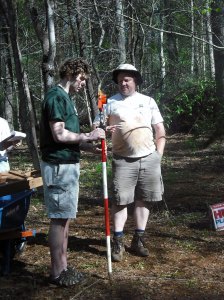
Don Gaylord (right) shows Ian Dexter '12 how to take elevations with a stadia rod and total station
Monday, April 20 Students checked into their spring digs: a gated apartment complex complete with volley ball court, a tri-level disappearing-edge pool, and tanning bed (!).
Tuesday, April 21 “Today was a learning experience to say the least.” Tyler Thompson ‘11
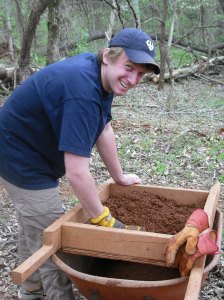
Tyler Thompson
Tuesday consisted of an orientation to archaeology and Monticello, beginning with a lecture by Dr. Fraser Neiman, Director of Archaeology, on archaeological means of reconstructing “The Lost World of Monticello.” Ms. Karen Smith, Curator of Archaeological Collections, introduced the students to artifacts that the Monticello crew had found at the overseer’s site the previous week.
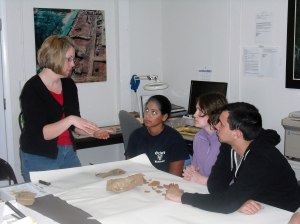
Karen Smith, Kathleen Ninan '11, Susan Payton '11 and Collin Neal '11
Next we toured Jefferson’s house, and finally Mr. Don Gaylord, Archaeological Analyst, led us on a plantation tour through the woods to explain how Monticello archaeologists have used shovel test pits over the last decade and more (about 17,000 pits in all!) to identify additional sites. Reflecting on the day, Alex Massey ’10 commented that “despite – or because of, perhaps – the sun, the rain, the dirt, and even the tics, I’m super excited to truly begin our dig tomorrow.”
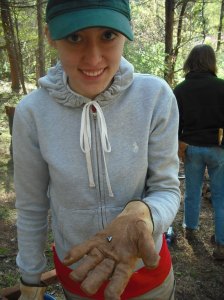
Alex Massey '10
Wednesday, April 22 “Today I saw a lot of dirt. Dirt with rocks, roots, leaves, and a few pieces of the good stuff. … What I’m realizing is that no matter how much I would like to call it all dirt, it has significance. The layers date and relate all the other objects trapped inside.” Francis Cullo ’12
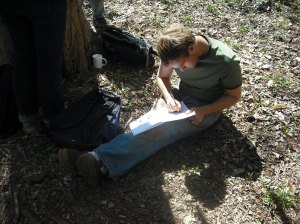
Francis Cullo '12 writing field notes
On Wednesday we trekked down to the site, about as far from the “big house” at Monticello you can get and still be on Monticello property. The site is wooded and on a slope; Jefferson noted it on an 1809 survey, and Monticello archaeologists located it using shovel test pits in their plantation survey several years ago. This morning students broke into small groups, and each began work on a five-by-five foot quadrat. They learned methods of establishing the quadrat (using known points established by a total station, pull tapes, and the Pythagorean theorem), how to “shovel skim” (remove thin layers of soil), trowel, screen soil, look for changes in soil characteristics, and record key aspects of the quadrat including elevations and soil color/texture.
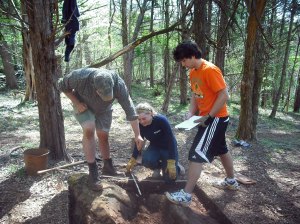
Richard Hahn '11, Erin Schwartz '12 and Colin Hayes '12 map their quadrat
We’ve emphasized the need for careful recording because excavating an archaeological site inevitably and irrevocably disassembles it. Kathleen Ninan ’11 observed: “I learned a lot about the methods used to keep records of each site, which were much easier to understand when we could actually see how each piece of data related to the site rather than just reading about it.” The effort involved to excavate and record sites properly is large, exacting, and deeply satisfying. Or as Collin Neal ’11 described his first field day and artifact finds: “I was really tired from working, but making a discovery was a great rush of energy.” And we did have some great artifact discoveries, especially on …
… Thursday, April 23 “This was the best day of class in college ever.” Richard Hahn ‘11
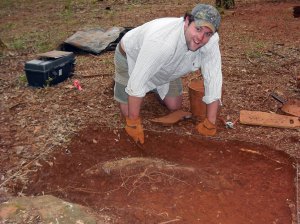
Richard Hahn '11 troweling quadrat
As per Monticello’s research design, we’re excavating the site this spring using a stratified random sample. This means that archaeologists establish a grid over the entire map of the site and choose quadrats within the grid to excavate based on a draw of random numbers. Because we’re aiming for objective testing at the site, quadrats are placed in areas of varying artifact densities, based on earlier shovel-test pit data, and students digging in different quadrats have encountered significantly different numbers of artifacts. Everyone will be rotated through the seemingly more- and less-artifact rich areas of the site during the course of the term. But students’ comments today – one from the most and one from the least productive quadrats – suggest how much they’re learning wherever they are:
“We found a ton of artifacts in unit 005 today! The big find was a sherd of Chinese export porcelain. We also found a good bit of hand-painted pearlware and shell-edge pearlware, a piece of glass that might have been part of a stemmed drinking vessel, and many nails, mostly hand-wrought. The pieces of brick and mortar point to the possibility that a brick-lined cellar or similar feature might have existed on this site.” Susan Payton ‘11
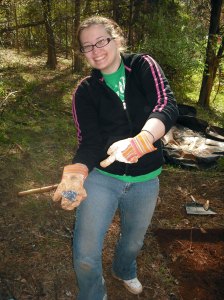
Danielle Maurer '12 with a sherd of Chinese export porcelain that she found
“One thing I learned today (and I think it may be the most important thing for the whole six weeks) is that you have two choices in archaeology, and it’s up to you to decide what choice you make. You can decide to be grumpy and moan about no artifacts, the work, etc., or you joke, keep up an optimistic spirit, and trek on. How you decide affects your entire experience.” Makenzie Hatfield ‘12
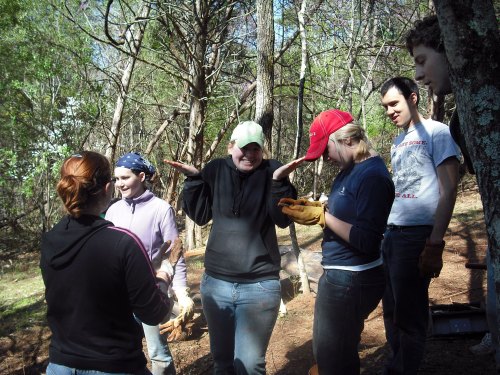
Makenzie Hatfield '12 at center and Aleisha Butler '10 at right
What an exciting opportunity, to be able to link academic training with such a challenging hands on experience. — David Novack (Chair, Dept. of Sociology & Anthropology at W&L).
I WANT TO BE THERE. Ya’ll seem to be having a wonderful time. Keep up the good work and postings with pictures.